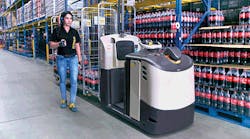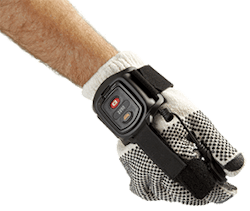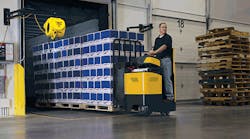Wearable warehouse management system (WMS) technologies, such as pick-to-voice systems, have largely delivered on their promise of improving productivity in low-level order picking. By eliminating the need for operators to continually refer to and update paper printouts, these systems have helped businesses achieve double-digit improvements in pick productivity. As a result, they are now commonplace in large warehouses.
Yet upon closer examination, the low-level order picking process is still noticeably inefficient even with support from voice-to-pick or other wearable technologies. It can take as many as nine discrete actions from when an operator places one case on a pallet to when they place the next case on the pallet (see "Typical Low-Level Order Picking Process" chart).
The complexity of what at first appears to be a simple task explains why order picking remains one of the most resource-intensive processes in the warehouse and thus a major target for automation. However, it is not a process that lends itself easily to automation. In existing warehouses, the process is difficult to fully automate because of the diversity of the pick list and established infrastructure, and it usually isn't feasible for distributors to abandon existing distribution centers and invest millions of dollars in new, highly mechanized warehouses.
Despite these realities, opportunities do exist to cost-effectively use automation to streamline the picking process. If you review the actions in the process, you'll see that four of the nine are associated with moving the forklift down the aisle to the next pick location. This continual repositioning of the forklift is time-consuming, increases the physical demands on the operator, and can create safety issues.
In addition to requiring the operator to get in and out of the forklift for each move, this approach causes operators to pick in a U-shaped pattern in which they are circumnavigating the truck multiple times as they work back and forth across the aisle, and consequently further increasing pick times.
The process would be more efficient if only the truck could move without the operator having to repeatedly climb on and off. This would compress the nine actions into just five, while minimizing the distance operators have to travel and reducing the physical demands of the job.
Varying Degrees of Automation
One way to accomplish this goal would be to integrate the forklift with the WMS, which would move the forklift down the aisle as the operator advances to the next pick location. But that turns out to be a less-than-ideal solution. The WMS may not position the forklift where the operator needs it to be. For example, if the forklift is positioned alongside the operator, it becomes a barrier between the operator and products across the aisle. Once again, the operator has to walk around the forklift to get to product, minimizing the benefits of automating forklift movement.
The integration of the WMS and the forklifts also unnecessarily complicates ongoing management of the system.
A better solution is to give the operator remote control of forklift position by adopting the same strategy that has already proven to be effective at increasing pick productivity: wearable technology. In addition to a headset, operators can be equipped with a wireless device that advances a modified forklift without the operator ever touching the vehicle.
This allows the operator to work from behind the forklift, moving back and forth across the aisle in an efficient Z-shaped pattern. Operators no longer have to interrupt their picking to climb on and off forklifts and can position trucks in the exact position they want them. Simple steer correction technology on the forklift keeps the truck in proper alignment with the aisle. Forklift sensors help enhance personnel, product and rack safety.
This technology, when supported by other process improvements, can cut an additional five seconds per pick off the process, essentially doubling the improvements realized through wearable WMS technology.
How valuable is five seconds per pick? If you assume a typical operator does about 100 picks/hour, a five-second reduction cuts the average pick time from 36 seconds to 31 seconds, enabling an additional 13 picks per hour per operator with less physical effort. That productivity improvement can minimize labor challenges, reduce warehouse costs and avert the need to expand existing facilities or build new ones.
Martijn Vogelzang, project manager at Jumbo Supermarkten in the Netherlands, utilized this approach at his facility. "Our trial resulted in a double-digit productivity improvement." Vogelzang says. "And, importantly for productivity, around 90% of our operators said it required less physical effort."
As mentioned earlier, this technology, like voice-enabled picking, delivers the greatest benefits when it is combined with other process optimizations. Some of these best practices include establishing one-way traffic flows, maintaining open aisles and adopting Z-shaped picking, among several other optimizations that should be considered in collaboration with an experienced material handling partner.
Automation is sometimes presented as an all-or-nothing proposition: You're either automated or you're not. Yet, the reality is there are degrees of automation. It can be expensive and disruptive to go directly from manual processes to fully autonomous vehicles. For many warehouses, automated solutions, such as forklifts controlled by wearable technology, represent a viable path to significant productivity improvements with a smaller capital investment and faster return on investment.
Jim Gaskell is director, global technology business development with forklift manufacturer Crown Equipment.






